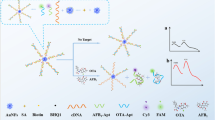Abstract
In this study, NaYF4:20%Yb, 2%Er upconverting nanoparticles (UCNPs) were synthesized by solvothermal method and characterized by transmission electron microscopy and upconversion fluorescence spectrometry. The results showed that the UCNP particles present good dispersion and uniform spherical shape with a size of 29 ~ 42 nm. Hydroxyl UCNPs were converted to hydrophilic carboxylic acid–functionalized ones by ligand exchange, and the streptavidin was attached on the surface of carboxylic acid–functionalized UCNPs via amide bond. The DNA nanosensors based on UCNPs with DNA probes have been successfully developed. Only the genomic DNA of Nosema bombycis can be specifically detected by the DNA nanosensors when the DNA of Bombyx mori and its pathogens was used as target DNA. When the DNA nanosensors were used to detect the DNA of N. bombycis, a broad emission peak signal appeared at 580 nm. There is linear relationship between the signal intensity and DNA concentration of N. bombycis, I580/I545 (R2 = 0.820) and I545/I654 (R2 = 0.901). The detectable minimum concentration of genomic DNA of N. bombycis was 100 ng/μL while the tested concentrations of N. bombycis genomic DNA were 3000 ng/μL, 1500 ng/μL, 1000 ng/μL, 500 ng/μL, 250 ng/μL, and 100 ng/μL, respectively. The whole detection process for target DNA takes less than 60 min.






Similar content being viewed by others
References
Chen Z, Chen H, Hu H et al (2008) Versatile synthesis strategy for carboxylic acid-functionalized upconverting nanophosphors as biological labels. J Am Chem Soc 130:3023–3029
Chen X, Zhao Z, Jiang M et al (2013) Preparation and photodynamic therapy application of NaYF4:Yb, Tm–NaYF4:Yb, Er multifunctional upconverting nanoparticles. New J Chem 37:1782–1788
Chatterjee DK, Gnanasammandhan MK, Zhang Y (2015) Small upconverting fluorescent nanoparticles for biomedical applications. Small 6:2781–2795
Dai WJ, Qi JR, Chen HL et al (2019) Rapid and sensitive detection of microsporidium Nosema bombycis using loop-mediated isothermal amplification and colorimetric nanogold. ScienceAsia 45:268–274
Franzen C (2005) How do microsporidia invade cells? Folia Parasitol 52:36–40
Fu ZWK, He XK, Cai SF, Liu H, He XY, Li MQ, Lu XM (2016) Quantitative PCR for detection of Nosema bombycis in single silkworm eggs and newly hatched larvae. J Microbiol Meth 120:72–78
Jaroenram W, Arunrut N, Kiatpathomchai W (2012) Rapid and sensitive detection of shrimp yellow head virus using loop-mediated isothermal amplification and a colorogenic nanogold hybridization probe. J Virol Methods 186:36–42
Jin JF, Gu YJ, Man CWY et al (2011) Polymer-coated NaYF4:Yb3+, Er3+ upconversion nanoparticles for charge-dependent cellular imaging. ACS Nano 5:7838–7847
Kokoskin E, Gyorkos TW, Camus A et al (1994) Modified technique for efficient detection of microsporidia. J Clin Microbiol 32:1074–1075
Lee SH, Joung M, Yoon S et al (2010) Multiplex PCR detection of waterborne intestinal protozoa: Microsporidia, Cyclospora, and Cryptosporidium. Korean J Parasitol 48:297–301
Mo L, Drancourt M (2004) Monoclonal antibodies for specific detection of Encephalitozoon cuniculi. Clin Diagn Lab Immunol 11:1060–1063
Polley SD, Boadi S, Watson J et al (2011) Detection and species identification of microsporidial infections using SYBR Green real-time PCR. J Med Microbiol 60:459–466
Stine SW, Vladich FD, Pepper IL et al (2005) Development of a method for the concentration and recovery of microsporidia from tap water. Environ Lett 40:913–925
Suebsing R, Prombun P, Srisala J et al (2013) Loop-mediated isothermal amplification combined with colorimetric nanogold for detection of the microsporidian Enterocytozoon hepatopenaei in penaeid shrimp. J Appl Microbiol 114:1254–1263
Su QQ, Feng W, Yang DP, Li FU (2017) Resonance energy transfer in upconversion nanoplatforms for selective biodetection. Acc Chem Res 50:32–40
Vávra J, Lukeš J (2013) Microsporidia and ‘the art of living together.’ Adv Parasitol 82:253–319
Wang F, Han Y, Lim CS et al (2010) Simultaneous phase and size control of upconversion nanocrystals through lanthanide doping. Nature 463:1061–1065
Wei K, Sun TY, Chen B et al (2017) A general strategy for ligand exchange on upconversion nanoparticles. Inorg Chem 56:872–877
Wilhelm S (2017) Perspectives for upconverting nanoparticles. ACS Nano 11:10644–10653
Yan W, Shen Z, Tang X et al (2014) Detection of Nosema bombycis by FTA cards and loop-mediated isothermal amplification (LAMP). Curr Microbiol 69:532–540
Zong LB, Wang ZM, Yu RB (2019) Lanthanide-doped photoluminescence hollow structures: recent advances and applications. Small 15:e1804510
Funding
This work was supported by China Agriculture Research System of MOF and MARA and the Science and Technology Innovation Fund Project of Zhenjiang City (NY2021020, SH2021066).
Author information
Authors and Affiliations
Corresponding author
Ethics declarations
Conflict of interest
The authors declare no competing interests.
Additional information
Publisher's Note
Springer Nature remains neutral with regard to jurisdictional claims in published maps and institutional affiliations.
Rights and permissions
About this article
Cite this article
He, P., Chen, H., Sun, J. et al. Use of DNA nanosensors based on upconverting nanoparticles for detection of Nosema bombycis by fluorescence resonance energy transfer. Folia Microbiol 67, 419–425 (2022). https://doi.org/10.1007/s12223-021-00938-1
Received:
Accepted:
Published:
Issue Date:
DOI: https://doi.org/10.1007/s12223-021-00938-1




